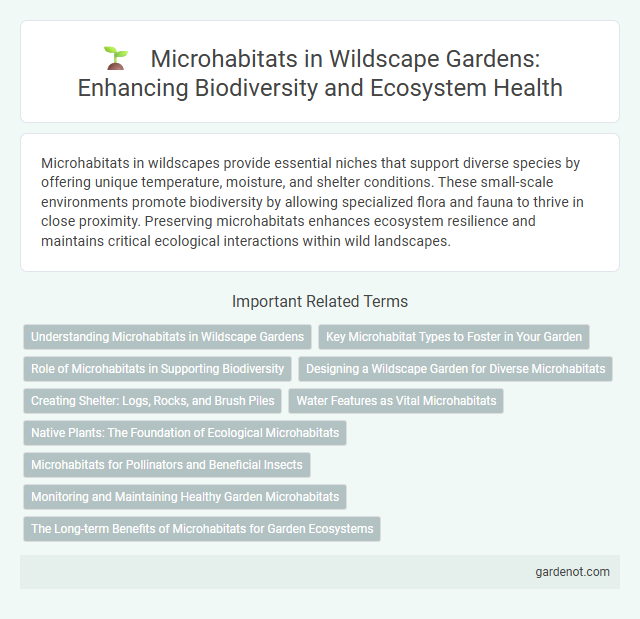Microhabitats in wildscapes provide essential niches that support diverse species by offering unique temperature, moisture, and shelter conditions. These small-scale environments promote biodiversity by allowing specialized flora and fauna to thrive in close proximity. Preserving microhabitats enhances ecosystem resilience and maintains critical ecological interactions within wild landscapes.
Understanding Microhabitats in Wildscape Gardens
Microhabitats in Wildscape gardens provide specialized environments that support diverse plant and animal species, enhancing local biodiversity. These small-scale habitats, such as log piles, ponds, and native plant clusters, offer essential resources like shelter, food, and breeding grounds. Understanding microhabitats enables gardeners to create balanced ecosystems that sustain wildlife and promote ecological resilience.
Key Microhabitat Types to Foster in Your Garden
Creating diverse microhabitats in your garden supports local wildlife and enhances biodiversity by providing shelter, food sources, and breeding grounds. Key microhabitat types to foster include log piles for decomposers and amphibians, wildflower meadows for pollinators like bees and butterflies, and pond areas that support aquatic insects and amphibians. Incorporating leaf litter zones, native shrubbery, and rock piles further promotes habitats for small mammals, reptiles, and ground-nesting birds.
Role of Microhabitats in Supporting Biodiversity
Microhabitats create essential niches that support diverse species by providing specific resources such as moisture, shelter, and food, which are critical for survival and reproduction. These small-scale environments enhance ecosystem complexity and resilience, allowing various organisms to coexist and maintain ecological balance. Protecting microhabitats within wildscapes is vital for preserving biodiversity and fostering sustainable wildlife populations.
Designing a Wildscape Garden for Diverse Microhabitats
Designing a wildscape garden for diverse microhabitats involves incorporating varied elements such as native plants, rocks, water features, and soil types to support a wide range of wildlife species. Creating microhabitats like sunny rock outcrops, shaded forest floors, moist ponds, and dry sandy patches enhances biodiversity by providing shelter, food, and breeding grounds for insects, amphibians, birds, and small mammals. Strategic layering of vegetation and natural materials helps mimic ecological niches, promoting a resilient and sustainable ecosystem within the garden.
Creating Shelter: Logs, Rocks, and Brush Piles
Logs, rocks, and brush piles form essential microhabitat structures that provide shelter for diverse wildlife, including amphibians, reptiles, and small mammals. These natural elements offer protection from predators, extreme weather, and serve as breeding or foraging sites, enhancing biodiversity within a wildscape. Strategically placing such features promotes ecosystem health by supporting habitat complexity and species richness.
Water Features as Vital Microhabitats
Water features in wildscape microhabitats support diverse aquatic and semi-aquatic species by providing essential resources such as hydration, breeding grounds, and food sources. These microhabitats enhance biodiversity by sustaining amphibians, insects, and plant life adapted to moist environments. Properly designed water features also improve ecosystem resilience by maintaining microclimate regulation and nutrient cycling.
Native Plants: The Foundation of Ecological Microhabitats
Native plants establish the foundation of ecological microhabitats by supporting local biodiversity and maintaining soil health within wildscapes. These plants provide essential resources such as food, shelter, and breeding grounds for native wildlife, promoting balanced ecosystems. Preserving native flora in microhabitats enhances resilience against environmental stressors and encourages long-term ecological stability.
Microhabitats for Pollinators and Beneficial Insects
Microhabitats for pollinators and beneficial insects in a wildscape include diverse flowering plants, native grasses, and undisturbed soil patches that provide essential nectar sources, nesting sites, and shelter. Incorporating a variety of bloom times ensures continuous food availability, supporting species like bees, butterflies, and predatory beetles throughout the growing season. Features such as hollow stems, leaf litter, and rock piles create critical microhabitats that enhance insect biodiversity and promote natural pest control.
Monitoring and Maintaining Healthy Garden Microhabitats
Regular monitoring of garden microhabitats in Wildscape environments involves tracking soil moisture levels, temperature variations, and native species presence to ensure ecological balance. Maintaining healthy microhabitats requires implementing sustainable watering practices, controlling invasive species, and enhancing plant diversity to support local wildlife. Employing sensor technology and periodic habitat assessments helps detect early signs of stress, allowing timely interventions to preserve biodiversity.
The Long-term Benefits of Microhabitats for Garden Ecosystems
Microhabitats within Wildscape gardens create essential niches that support diverse flora and fauna, enhancing overall ecosystem resilience. These small, specialized environments promote pollinator activity, natural pest control, and soil health by fostering symbiotic relationships between plants, insects, and microorganisms. Over time, microhabitats contribute to biodiversity preservation and ecological balance, making garden ecosystems more sustainable and self-sufficient.
Microhabitat Infographic

 gardenot.com
gardenot.com